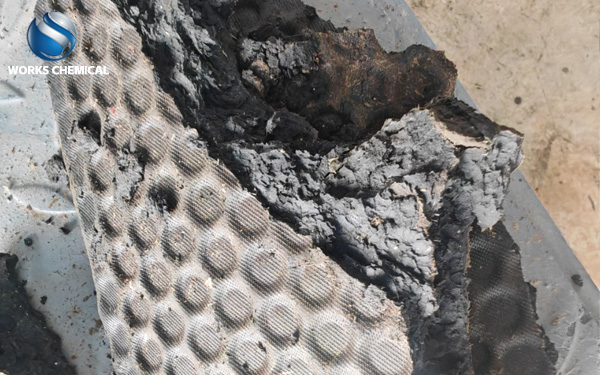
In the past, materials like polyaluminium chloride (PAC), polymeric ferric sulfate, and polymeric aluminium sulfate were more common in the deep dewatering of sludge plates and frames in the Guangdong region. PAC has a good coagulation effect, which can promote the aggregation of sludge particles, improve the solid-liquid separation effect, and also adjust the pH value to stabilize the acidity and alkalinity. Polymeric ferric sulfate can quickly form large iron flocs, accelerate the speed of solid-liquid separation, and has good corrosion resistance and alkali resistance, making it suitable for complex wastewater environments. Polyaluminium sulfate has an excellent phosphorus removal effect and is often selected for the treatment of high-phosphorus wastewater. It also has strong coagulation and flocculation capabilities.

However, these traditional dehydrating agents have many shortcomings. Take polymer flocculants as an example. When used in plate and frame machines, they can clog the filter cloth and affect the normal operation of the equipment. Although the addition of inorganic salts (such as iron salts, calcium salts, etc.) as regulators can achieve cement separation, the large dosage will increase the amount of dry sludge, reduce the calorific value of dry sludge, and raise the subsequent disposal costs. Moreover, traditional water treatment chemicals such as ferric chloride/aluminum + lime, polyaluminium chloride + polyacrylamide, persulfate + lime, etc. not only require large dosages, but also the treated sludge still contains a large amount of water. They can also seriously corrode equipment, greatly increasing the operating costs of enterprises.
The advantages of the new type of sludge dewatering agent - sludge efficiency enhancer have become prominent
In view of the various drawbacks of traditional dewatering agents, new types of sludge dewatering agents have emerged, among which sludge efficiency enhancers have performed outstandingly. Sludge enhancers can change the surface structure of sludge, reduce the solid surface load and specific surface area of sludge, and destroy the structure of bacteria. Its main components include inorganic compounds, sludge surface structure modifiers, degreasing agents, cell wall disruptors, sludge surface treatment agents, sludge stripping agents, etc.
The sludge enhancer has significant advantages when used in combination with the plate and frame machine. Firstly, it has an excellent dewatering effect, reducing the moisture content of sludge from over 90% to 40% - 60%, and in some cases, it can even be as low as 35% - 55%. The weight reduction of sludge is remarkable, achieving deep dewatering. Secondly, it has significantly enhanced the sludge pressing efficiency of the plate and frame filter press, increasing the efficiency by 100% to 500%, greatly shortening the sludge pressing cycle and improving production efficiency. Furthermore, the dosage of sludge enhancer is small, no lime needs to be added, and it does not contain chloride ions. It has no corrosive effect on dewatering equipment, reducing equipment wear and maintenance costs. Meanwhile, the sludge treated by it is conducive to subsequent disposal methods such as incineration, brick-making and composting. Moreover, during use, it does not stick to the filter cloth, reducing the frequency of filter cloth replacement and further saving operating costs.
Application examples of sludge enhancers in different industries
In the field of domestic sewage treatment, a certain city's sewage treatment plant previously used traditional dehydrating agents. The moisture content of the sludge cake pressed by the plate and frame machine was as high as 80%, and the sludge pressing cycle was long. After switching to the sludge enhancer, the moisture content of the sludge cake was reduced to around 50%, and the sludge pressing cycle was shortened from the original 24 hours to 8 hours. This significantly improved the treatment efficiency and reduced the subsequent sludge disposal costs.
The sludge in the printing and dyeing industry is complex in composition and difficult to dewater. A certain dyeing and printing factory has successfully reduced the moisture content of sludge from 95% to 45% by using sludge enhancers in combination with plate and frame machines for dewatering. This has solved the long-standing problem of sludge dewatering, and the treated sludge meets the requirements for subsequent landfill and incineration.
The papermaking industry generates a large amount of sludge, and traditional dehydrating agents are not very effective. After using the sludge enhancer, the sludge intake of the plate and frame machine increased, the thickness of the sludge cake grew and the moisture content decreased. The difference in dryness between the inside and outside was small, and there was no "runny" sludge cake phenomenon, achieving efficient sludge dewatering and reduction.
The usage method and precautions of sludge enhancers
When in use, first mix the sludge in the sludge thickening tank (or the sludge pressed out by the belt sludge press with water) to make the solid content of the sludge between 4% and 10%. Next, add a sludge enhancer of 20% to 45% of the absolute dry sludge volume to the sludge and react for 10 to 20 minutes. Afterwards, the well-reacted sludge is pumped into a high-pressure plate and frame filter press for filtration. During the operation process, it is necessary to pay attention to controlling the solid content of the sludge and the proportion of chemical agents added. The optimal parameters for sludge of different industries and properties need to be determined through small-scale tests. At the same time, ensure that the reaction time is sufficient to allow the chemicals to fully react with the sludge, so as to achieve the best dewatering effect. It is also necessary to regularly inspect the equipment, especially the filter cloth. Although the sludge enhancer does not stick to the filter cloth, maintenance is still required after long-term use to ensure the normal operation of the equipment.